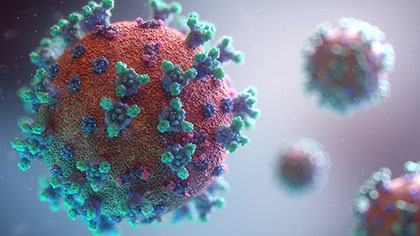
Author: Julie Kiefer
 Ongoing debate about the origin of the pandemic continues. Did SARS CoV-2, the virus that causes COVID-19, originate in wild animals that then infected humans? Or did it leak from a lab? Twenty one scientific experts, including University of Utah scientist Stephen Goldstein, PhD, published a critical review in the journal Cell, laying out the evidence supporting an animal origin. Goldstein discusses what we do and don’t know, along with steps that need be taken to prevent another pandemic from emerging in the future.
Ongoing debate about the origin of the pandemic continues. Did SARS CoV-2, the virus that causes COVID-19, originate in wild animals that then infected humans? Or did it leak from a lab? Twenty one scientific experts, including University of Utah scientist Stephen Goldstein, PhD, published a critical review in the journal Cell, laying out the evidence supporting an animal origin. Goldstein discusses what we do and don’t know, along with steps that need be taken to prevent another pandemic from emerging in the future.
This paper provides evidence that it's unlikely that the pandemic was caused by a lab accident that released the virus into the human population. Why did this group feel it was important to write this review?
Looking at how this conversation has progressed over time, it seemed to us that in the public eye there was momentum building toward arguing that this virus came out of a lab without any new evidence having emerged in support of that. In fact, additional evidence has emerged in support of the idea that this virus came out of animals. We felt like the public discussion was out of balance, and, at least in the last year or so, this topic hadn't received a critical scientific review. It was time to put something like that out there.
What are the main takeaways from this work?
The early cases of the origin of the epidemic in Wuhan, China, clearly seemed to be centered in this district of Wuhan surrounding a market called the Huanan Seafood Market. When they were in Wuhan, the WHO investigations team was told that there were no live mammals sold at that market. But in June, a really important paper was published from Chinese and Canadian wildlife researchers showing, in fact, that through November 2019, when we believe this virus first entered the human population, many animals known to be susceptible to SARS-CoV2, the virus that causes COVID-19, were in fact sold at this market and other markets. Those are two important pieces of evidence that we put together here.
The paper presents a striking map of the area showing the location of the markets. Spots indicating where some of the first cases occurred radiate outward from that area over time. Can you talk a little bit more about what this map shows?
This map shows that the early cases in December 2019 are close to the market. Then, as cases build, they continue to be centered around that market. Just as significantly, we looked at excess deaths. You could posit that you don't catch the early cases because of a bias towards detecting cases associated with the Huanan market, and other parts of the city may have been missed. But we know that wherever this virus goes, it also causes excess deaths.
We looked at the districts in Wuhan where excess deaths first appeared. Again, that maps to the district surrounding the Huanan market and not really to any other part of the city. This suggests that the epidemic began in markets in this district: the Huanan market and possibly other markets as well.
It doesn't tell us about that very first introduction of this virus into the human population, but it tells us about everything that was going on not long after that. It tells us where the epidemic began and where intense transmission began.
Viral transmission wasn’t the only thing examined. This paper takes a close look at the virus itself, too.
One theory that's been going along with the lab leak theory is that this virus was somehow the product of genetic engineering by humans. We took a really close look at that, and we found no evidence for that at all. We actually looked at some of the genomic features of the virus and found them totally consistent with natural evolution, with this virus being a product of natural evolution in animals in the wild. That is something about which we really have no doubt.

Have you ruled out the idea of the virus coming from a lab?
We can't rule out the possibility of a lab accident. It can't be dismissed entirely, but there's no evidence for it right now. The weight of evidence that we do have points to this pandemic emerging from markets in Wuhan that sold wildlife, probably illegally. That could have been only at the Huanan market that's been the focus of much attention. It could have occurred at the Huanan market and other markets, essentially simultaneously. The data is consistent with either market scenario, and we just don't know which right now.
What has to happen to prove one theory or the other?
With respect to the animal spillover theory, the gold standard would be finding animals sold in the markets that were infected with this virus. But the opportunity for that to happen is pretty much gone. Any of these investigations do require collaboration from the Chinese government, which looks like it's going to be a tall task.
Something I would like to see done is looking at people who work in the wildlife trade, all the way from people who transport animals from farms to markets to people who sell these animals at markets. Then, see if those people were exposed to this virus more intensely than people in the general population. That would really suggest that they were exposed through the course of their work, meaning that they would have come into contact with infected animals. That's a study that's pretty simple to do in theory, but you can't do it if you don't have access to the people in China.
From the lab leak side, the key piece of evidence that we would want to see is that there is evidence that this virus was present in a lab before the pandemic. Right now, there's no evidence that this virus was known to humanity before it was first identified in patient samples in Wuhan in December 2019.
Since this work came out as a preprint, things have already changed. What else has happened in the interim?
The WHO made some recommendations for the next stage of the investigation. The first four relate to continuing to investigate how this virus could have entered the human population via spillover from an animal reservoir. They also recommended taking a closer look at the lab. We all think that that's fine to include as one of the things we're going to do. The concern is that there would be a focus on the lab at the expense of following the animals, so to speak.
There's a lot of very heated discussions happening around this topic. Why do you think this is so polarizing?
It’s hard for me to speculate. It could be that the possibility this virus came from animals does not seem extraordinary enough to have sparked this kind of extraordinary global event, but that's where the evidence stands right now. Our hope is that we can push momentum back toward critical reviews of the evidence and not speculation, suspicion, and innuendo.
Something we all can agree on is that we want to know how this pandemic arose. Once we find out, what can we do with that information?
The key thing to do if we're able to determine that it came out of animals would be to cut off the pathways that allow these viruses to go from animals into people. After the first SARS epidemic in 2002 and 2003, markets were not shut down initially. SARS re-emerged in markets the next winter, and then markets were shut down. Live animal sales at these markets were shut down for quite some time, but they reopened because there was no political will in or outside China to make permanent changes in this specific area.
But now with the magnitude of this pandemic, I think if we're able to find strong evidence that this virus came out of markets, we can try to muster the political will to change this dynamic permanently. It would be important to stop having live wild animals that are susceptible to these viruses coming into such close contact with people on a regular basis.
If it did come out of a lab, of course you would want to look at how that happened and institute new procedures [such as] stricter biosafety regulations or something to prevent that from happening again. But we can do that anyway. That's a conversation that we can have without this virus having had to come out of the lab. But if all the focus is on the lab and not the animals, we will not find the political will to make permanent changes.
Regardless, crossover of viruses from animals to humans happens fairly often. Is that something we need to be thinking about anyway?
One of the first things that needs to happen is we need to set up better surveillance systems to understand what viruses are coming from animals into humans before they explode into the human population. A major contact point between animals and people is both the wildlife global wildlife trade and agriculture. One thing we can do is set up surveillance of, for example, agricultural workers. If these people who work in these professions get sick and we don't understand why, we can figure out why and then figure out how those viruses are getting into these people. We can modify practices, shut down certain practices, and do what we need to do to prevent that from becoming a bigger problem.